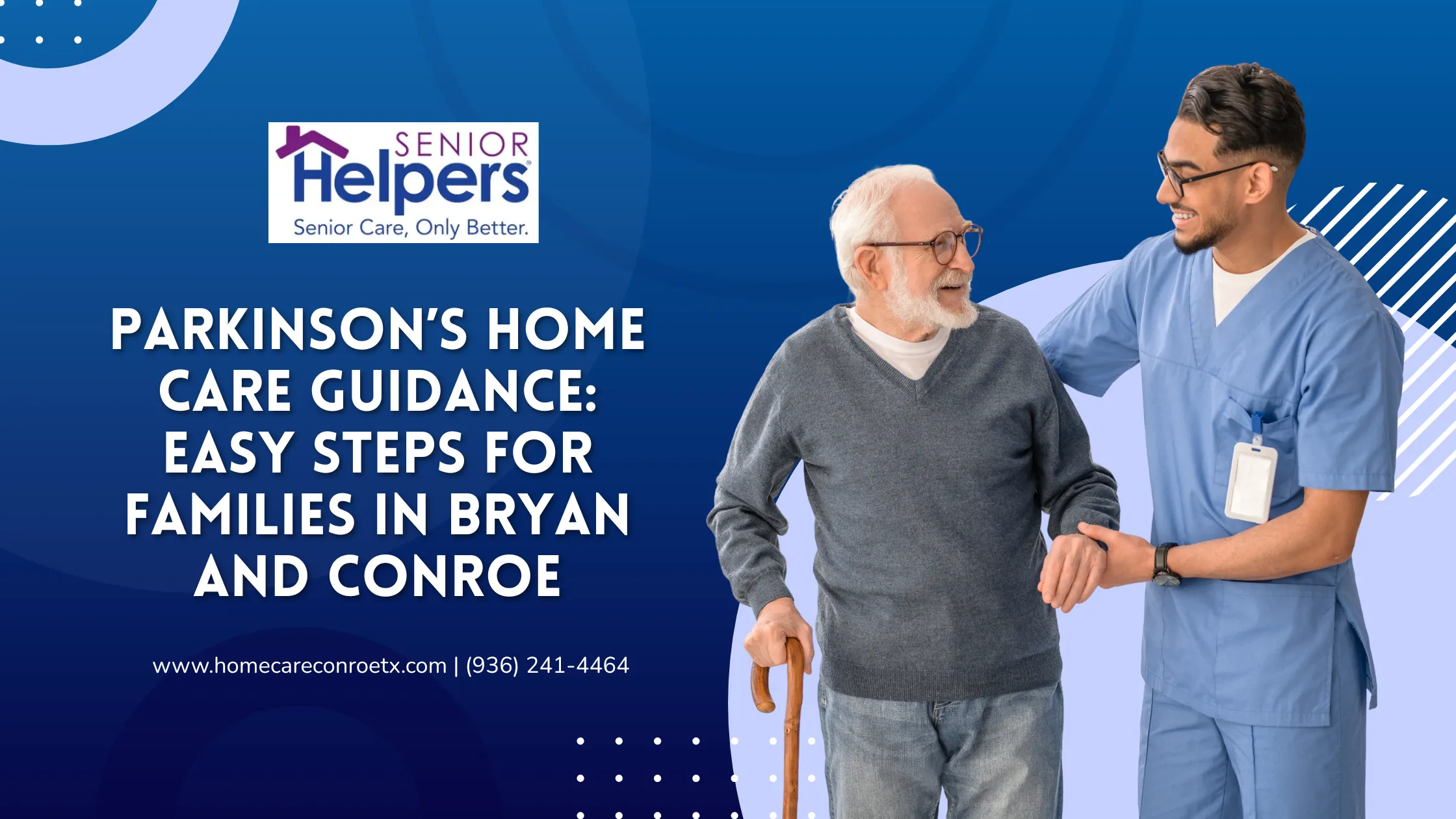Caring for someone with Parkinson’s is an emotional and physical journey. The routines change often. Mobility can become limited. And your patience gets tested. But the more practical your approach, the smoother the path ahead.
This guide gives you clear, realistic ways to provide Parkinson’s home care — with confidence — whether you’re in Bryan, Conroe, or nearby communities.
1. Get to Know the Condition First
Understanding the symptoms helps you stay two steps ahead.
Parkinson’s affects movement, balance, speech, and mood. It’s progressive — symptoms change over time. What works today may not work next month.
Knowing what to expect helps you anticipate needs, prevent injuries, and stay calm when new behaviors show up.
2. Set Up a Safe and Predictable Home
A structured home gives confidence and reduces daily stress.
Making small safety updates at home can prevent falls and support independence.
Try this:
- Remove floor clutter and secure cords
- Install grab bars and handrails
- Use nightlights along walkways to prevent nighttime confusion
- Choose sturdy chairs with arms for easier standing
- Ensure shoes have non-slip soles
3. Build a Routine That Matches Their Energy
Consistency calms the nervous system and prevents burnout.
People with Parkinson’s often have better energy early in the day. A gentle routine helps balance rest with activity.
Sample day:
- Morning: Take meds, stretch gently, eat breakfast
- Midday: Do an easy task (puzzle, laundry), have lunch
- Afternoon: Quiet time, light reading, or music
- Evening: Dinner, warm bath, early bedtime
Even a flexible routine makes a big difference.
4. Support Movement, But Let Them Try First
Care is a partnership — offer help, not control.
Mobility will change. But moving a little on their own helps with strength and confidence.
How to help safely:
- Let them try standing or walking before stepping in
- Use stable furniture and mobility aids
- Avoid rushing movements — wait patiently
- Install adaptive tools like lift chairs or toilet risers
Professional personal care providers can also assist with safe transfers and movement at home.
5. Speak Clearly, Slowly, and Face Forward
Parkinson’s affects how people speak, listen, and react.
Conversations can slow down. That’s normal. Just adjust your delivery.
Do this:
- Face them directly when talking
- Use short, simple phrases
- Give extra time to respond
- Avoid background distractions like TV or loud music
Simple communication changes reduce frustration on both sides.
6. Encourage Gentle Daily Activity
Movement matters — just keep it low-impact and flexible.
Even 15–20 minutes of movement improves circulation, mood, and mobility.
Easy ideas:
- Stretching while seated
- Walking short laps inside the house
- Doing laundry with assistance
- Gardening with ergonomic tools
Some Bryan and Conroe home care agencies offer guided movement plans and physical therapy services in-home.
7. Keep an Eye on Emotional and Cognitive Changes
It’s not just physical — emotions and thinking can shift too.
Parkinson’s often brings anxiety, depression, and memory problems. These may show up as confusion, irritability, or quiet withdrawal.
Be proactive:
- Ask how they feel in simple terms
- Encourage open conversation — even if it’s short
- Watch for medication side effects
- Talk to a doctor if mood changes last over a week
If things escalate, caregivers trained in chronic condition support can help with safe interventions.
8. Carve Out Time for Yourself
You can’t give your best when you’re running on empty.
Caregiver fatigue leads to burnout, and it affects both of you.
How to recover:
- Take a walk, even if it’s just 15 minutes
- Ask a sibling or neighbor to sit in for an hour
- Use respite care options once a week
- Don’t feel guilty for needing rest — it’s essential
You deserve peace, too.
9. Prepare a Care Plan Before Things Escalate
Having a plan reduces fear and chaos later.
Parkinson’s changes fast. Planning early gives you — and your loved one — more control.
To start:
- Document medications, routines, and emergency contacts
- Discuss wishes for long-term care or hospitalization
- Look into return-home care programs
- Organize legal documents and care preferences
Don’t wait for a crisis to figure out what to do next.
10. Lean on Trusted Professionals in Bryan and Conroe
The right help can lift a huge weight off your shoulders.
If you’re feeling overwhelmed, you don’t have to keep pushing alone. Experts are trained to help with everything from bathing to balance.
For professional care built around Parkinson’s needs, check out these care experts in Bryan and Conroe.
You can also find trusted support through this Google business profile for Senior Helpers.
Final Word
Parkinson’s home care isn’t about perfection. It’s about showing up, making small adjustments, and knowing when to ask for help. Every safe step you make today adds comfort and dignity tomorrow.
If you’re ready to get support that truly understands Parkinson’s disease, reach out now and explore care options designed just for you.



